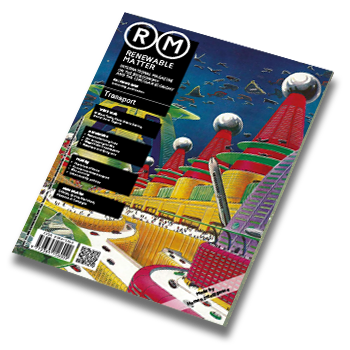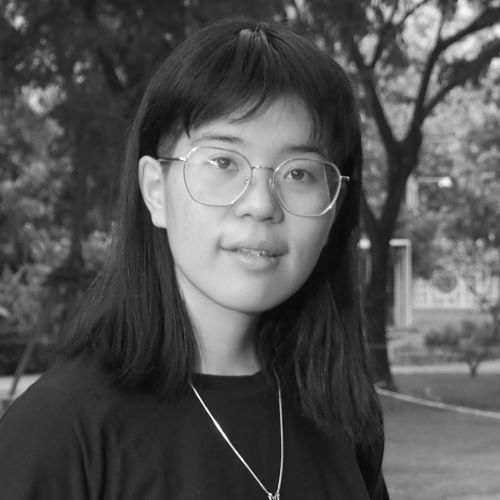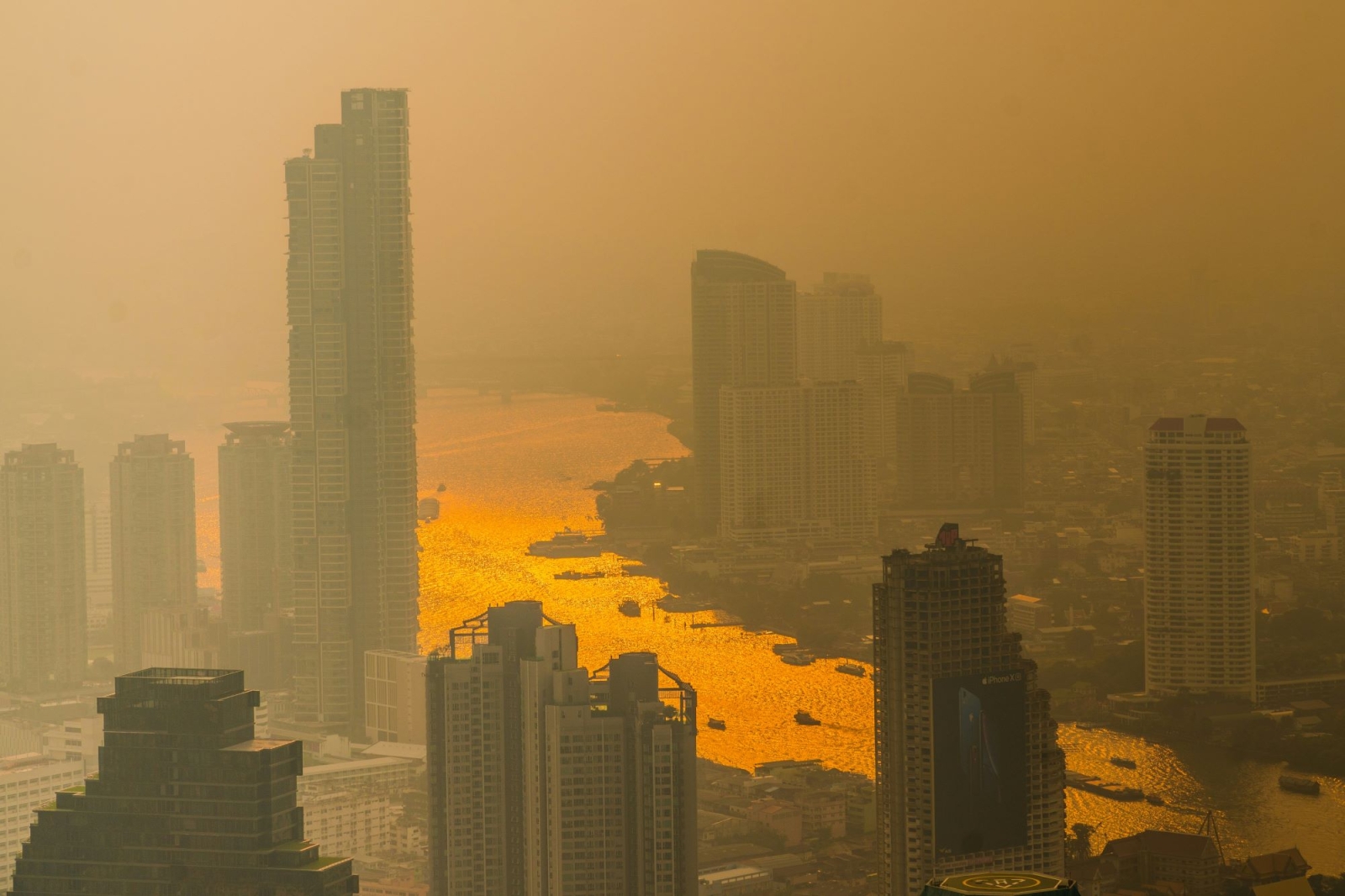This is the first article of the three-part series Bioplastic: green innovation or another plastic problem? an international investigation jointly published by Renewable Matter ‒ along with Eu Observer, LRT Lithuanian National Television, and TAZ ‒ through the support of Journalismfund Europe.
The second article is available at this link. The following part will be published in Renewable Matter in the coming weeks.
Mandatory masks to protect against Covid have long been gone in Bangkok, but people still cover their faces every day when they go out on the street, either with a piece of cloth or the more standard surgical masks. It is the 11th of December, and the capital of Thailand is already covered in a blanket of smog that is drastically worsening air quality. Between electric tuk-tuks and new cabs running on natural gas, the poor air quality is no longer due as it once was to the exhaust fumes of unlikely means of transportation.
Nowadays, particulate pollution is increasingly caused by an agricultural practice that is still quite common on rice and sugarcane plantations: field burning. The purpose is to quickly remove leaves and excess plant matter to facilitate the harvesting stage.
PLA: the biopolymer of disposability
December in Thailand marks the beginning of the harvest season for sugarcane, one of the most widely used renewable raw materials to produce the biopolymer PLA or polylactic acid. This type of bioplastic, which is only biodegradable in proper composting facilities, is increasingly filling the shelves of Italian supermarkets as disposable products such as tableware and cups or as containers to store food.
Marketing makes them all seem the same: green-tinted packaging with the words "eco", "organic", "green," and possibly with hints of nature to make consumers feel like friends of the planet. Replacing traditional plastics with bioplastics is often branded as the solution to all the environmental woes caused by fossil plastics: ocean pollution, microplastics, carbon emissions, and disposal.
A promise that riding the wave of enthusiasm for green innovation forgets to address the real (plastic) elephant in the room: the single-use model. A way of consumption that does not go out of style and that often through bio-based or biodegradable solutions merely changes its appearance but not the essence of the problem.
Single-use bioplastic packaging or products are not just made from PLA produced from sugarcane. They can vary in both feedstock - from corn starch used in North America to European starch from potatoes and beets - and compostable polymer blends that may contain monomers derived from fossil sources. There also exist many pilot projects targeting so-called second-generation feedstocks, i.e. those alternative raw materials that include crops intended for non-food use or agricultural by-products such as waste and processing residues. At present, however, it is complex to make this circular process economically viable.
Of the numerous bioplastics on the market, we decided to focus on PLA because it takes up the largest share of the market (31%) and according to estimates by the European Bioplastic Association will account for nearly 50% of production by 2028. Packaging remains the largest application segment, and speaking with several manufacturers, PLA seems to have the right characteristics to meet the stiffness and strength requirements of packaging and single-use items. That is, at least up to certain temperatures.
TotalEnergies Corbion, one of the world's largest PLA producers, knows this well. In 2017, the Netherlands-based company decided to establish a biorefinery in Thailand, a country rich in renewable resources that claims to be the world's second-largest producer of bioplastics. King Maha Vajiralongkorn plans to make his Thailand the world's leading hub of bioeconomy.
Thailand, 'black snow' falls from plantations
Pirom Rudee owns 80 hectares of sugarcane plantation in the Wang Muang district in the province of Saraburi, 160 km north of Bangkok. Like many other farmers in the area, he sells sugarcane to the Thai Roong Ruang Sugar Group (TRR), which owns most of the country's sugar mills. After the extraction process, TRR sells the sugar to bioplastics producer TotalEnergies Corbion (a joint venture of the French oil company TotalEnergies), which obtains lactic acid through a bacterial fermentation process. At the Rayong production site, this acid is converted into a type of PLA marketed as Luminy, a material considered "sustainable" under the principles of European taxonomy. The biorefinery has a production capacity of 75,000 tons per year.
Many Thai farmers, like Rudee, burn fields to make sugarcane harvesting faster and reduce labour costs. The combustion emits black carbon, a visible pollutant in the form of soot - known in Thailand as himadum (black snow) - which is considered by the government environmental agency to be one of the main causes of air pollution in the country.
In Saraburi province, the harvest season began on the 10th of December, and Rudee reveals that he has used burning in some of his fields, admitting that it is a simpler and quicker way to remove excess vegetation. While tractors would be capable of doing this, in addition to being very expensive (from US$17,000 to US$300,000) they cannot operate on rocky terrain.
A spokesman for the Wang Muang sugarcane growers Association assures Renewable Matter that over half of the farmers manage to rent machinery or use manual labour, while "only 10% still resort to harmful burning practices." Nevertheless, last year, in the Saraburi province particulate matter levels exceeded allowable limits several times. Given atmospheric data, the numbers don't add up.
Although the Thai government's environmental policies promote more sustainable practices, at the national level things have not improved as expected: from the tragic figures of 2018, when nationwide 60% of harvested sugarcane came from burned hectares, the numbers dropped to 26% in 2021. But over the following seasons, the figures have risen again (32%), despite the government's promise to bring burning practices to zero by 2024.
In a business where harvest speed is everything and incentives to change are almost nonexistent, plantation owners think it is too expensive to sell a zero-emission product. Burning the fields can result in harvesting three times as many tons of sugarcane in a single day. In addition, Pirom Rudee points out that sugarcane supported by controlled combustion provides better quality raw material with a high level of sweetness. This would also affect the amount of lactic acid produced.
TotalEnergies Corbion's bioplastic smells like smoke
According to data from the government institute Office of Cane and Sugar Board (OCSB), during the 2021/2022 season, the TRR group purchased 3.86 million tons of sugarcane harvested through the use of combustion. TotalEnergies Corbion's second major supplier is Mitr Phol, which bought 5.36 million from farmers during the same period. Both suppliers are expected to adhere to the Sugar Cane Code, a code of conduct envisioned by TotalEnergies Corbion to improve suppliers' agricultural practices and make the process truly sustainable.
Even though TRR group followed the national incentivizing programs by paying 120baht (3.08 euro) per tonne higher for non-burnt sugar cane, the company does not have a fixed proportion targets this year in buying sugar cane from farmers who use burning practices. Ugrit Asadatorn, president of the TRR group, wishes farmers would stop setting fires that cause pollution. "Despite the expected drop in production this year due to drought, I estimate that we will still buy approximately 20% of the cane following burning practices", he added.
"A sustainable agricultural supply chain is essential for the communities where we operate," replied TotalEnergies Corbion to our request for comment. However, the code, written according to the sustainability standards defined by the certifying body Bonsucro, is non-binding and simply recommends the minimisation of environmental impacts.
In all this, the farmers are left by themselves. Rudee admits that not all farmers in the association have joined the Bonsucro programme. "There are no benefits. For joining, we get some fertilisers and some advice, but they do not pay us more to avoid burning the fields." To find out whether suppliers follow the code of ethics, TotalEnergies Corbion suggests we ask them directly.
There are currently just over 2% Bonsucro-certified cultivation areas in Thailand, and TotalEnergies Corbion has only purchased 21% of certified sugar in 2022. Numbers, however, that hardly seem to count in the company's white paper, marketing Luminy biopolymer as a product that reduces carbon footprint by 75% compared to traditional plastic. Maelenn Ravard, Sustainability Manager, assures us that “combustion practice is included among the factors that can influence Luminy's carbon footprint”, yet in the report, there is no mention of the impacts caused by fine particulate pollution.
The Eldorado of bioplastics and the impacts of production
Thailand began seriously focusing on bioplastics production in July 2008, when the government approved a $50 million national plan to build a major hub of the bioeconomy. Thailand's vision of a Bio-Circular Economy is also embraced by the European Union, which views it as an excellent laboratory for experimenting with the biobased materials of the future.
It is therefore no coincidence that two bioplastics bigwigs such as TotalEnergies Corbion and NatureWorks have decided to invest in a land so rich in plant resources (even cassava starch is used). In addition to PLA produced in the vast corn plantations in Nebraska, NatureWorks will open a new biorefinery north of Bangkok in 2025. “It will be an innovative and much more efficient process,” inside sources tell us.
Besides the burning of sugarcane, the main environmental concerns related to the development of Thailand's bioeconomy are land and water scarcity. Crops such as sugarcane compete with rice for limited agricultural land, while water scarcity is a source of worry for crop yields: sugarcane requires a lot of water and suffers from drought periods.
While PLA production has been proven to require less fossil fuel than conventional polymers, it may also have high environmental impacts in terms of pollution of water bodies. This is caused by the use of fertilisers, pesticides, and the land-use conversion required for increased agricultural production. An increase that was reflected in the expansion of sugarcane plantations of 408,000 hectares by the Thai government between 2014 and 2019.
Nowadays, the main country where TotalEnergies Corbion exports the Luminy biopolymer is Italy, the queen of disposables. A country that, as we will see in the next part of this investigation, is leading the European disposable bioplastic trade by disobeying the bans of the European Single-Use Plastic directive (SUP).
Daiva Repeckaite and Jelena Malkowski contributed to this investigation
This article is also available in Italian / Questo articolo è disponibile anche in italiano
Cover image: Peggy Anke, Unsplash
© all rights reserved




